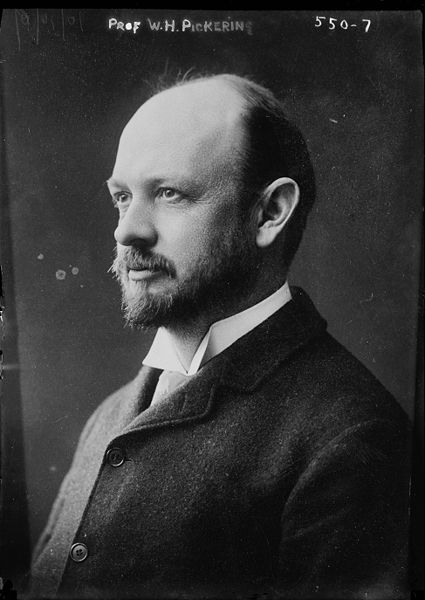<Back to Index>
- Astronomer William Henry Pickering, 1858
- Geologist Frank Bursley Taylor, 1860
PAGE SPONSOR

William Henry Pickering (February 15, 1858, Boston – January 17, 1938, Mandeville, Jamaica) was an American astronomer, brother of Edward Charles Pickering. He was elected a Fellow of the American Academy of Arts and Sciences in 1883.
He discovered Saturn's ninth moon Phoebe in 1899 from plates taken in 1898. He also believed he had discovered a tenth moon in 1905 from plates taken in 1904, which he called "Themis". For this discovery he was awarded the Lalande Prize of the French Academy of Sciences in 1906. Unfortunately "Themis" does not exist.
Following George Darwin, he speculated in 1907 that the moon was once a part of the earth and that it broke away where now the Pacific Ocean lies. He also proposed some sort of continental drift (even before Alfred Wegener) and speculated that America, Asia, Africa and Europe once formed a single continent, which broke up because of the separation of the moon.
In 1908 he made a statement regarding the possibility of airplanes that had not yet been invented, saying that "a popular fantasy is to suppose that flying machines could be used to drop dynamite on the enemy in time of war".
He led solar eclipse expeditions and studied craters on the Moon, and hypothesized that changes in the appearance of the crater Eratosthenes were due to "lunar insects". He also claimed to have found vegetation on the moon.
In 1919, he predicted the existence and position of a Planet X based on anomalies in the positions of Uranus and Neptune but a search of Mount Wilson Observatory photographs failed to find the predicted planet. Pluto was later discovered at Flagstaff by Clyde Tombaugh in 1930, but in any case it is now known that Pluto's mass is far too small to have appreciable gravitational effects on Uranus or Neptune, and the anomalies are accounted for when today's much more accurate values of planetary masses are used in calculating orbits. When the planet was named, he interpreted its symbol as a monogram referring to himself and Lowell by the phrase "Pickering - Lowell".
On August 24, 2006, the International Astronomical Union (IAU) defined what it means to be a "planet" within the Solar System. This definition excluded Pluto as a planet and added it as a member of the new category "dwarf planet" along with Eris and Ceres.
Pickering constructed and established several observatories or astronomical observation stations, notably including Percival Lowell's Flagstaff Observatory. He spent much of the later part of his life at his private observatory in Jamaica. He produced a photographic atlas of the Moon: The Moon: A Summary of the Existing Knowledge of our Satellite — New York, 1903.
The asteroid 784 Pickeringia, and the craters Pickering on the Moon
and Pickering on Mars, are jointly named after him and his brother
Edward Charles Pickering.
Frank Bursley Taylor (1860 – 1938) was an American geologist, the son of a lawyer in Fort Wayne, Indiana. He was a Harvard dropout who studied privately financed in large part by his wealthy father. He became a specialist in the glacial geology of the Great Lakes, and proposed to the Geological Society of America on December 29, 1908 that the continents moved on the Earth's surface, that a shallow region in the Atlantic marks where Africa and South America were once joined, and that the collisions of continents could uplift mountains. His ideas were based on his studies on mountain ranges as the Andes, Rockies, Alps and Himalayas. He concluded that these mountains could have been formed only as a result of titanic lateral pressures that thrust the earth's surface upward. His theory was either ignored or opposed by other scientists of his time.
Frank Bursley Taylor's ideas about continental drift were independently discovered by Alfred Wegener in Germany three years later, on January 1912, but even with Wegener's extensive extra research the idea did not achieve acceptance until the 1960s when a vast weight of evidence had accrued via Harry Hess, Fred Vine and Drummond Matthews. The initial key to his proposal, the complementary shapes of the continental masses, had been observed as early as the 16th century by Abraham Ortelius, but had lacked a credible driving force. His own proposition was that the moon was captured by the Earth's gravity during the Cretaceous period 100 million years ago, and came so close to the earth that its tidal pull dragged the continents toward the Equator. This lacked evidence, thus undermining the credibility of the continental drift observation. He had proposed that the continents ploughed through the ocean floors towards the equator, wrinkling their Equator - facing fronts to produce the Himalayas and Alps.